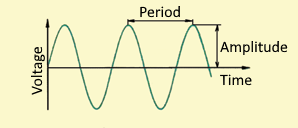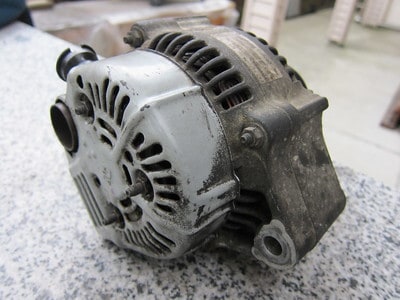It’s easy to get confused when it comes to electricity since there are so many abbreviations and confusing concepts.
In this article, we’ll take a brief look at AC (alternating current) and DC (direct current), talk about the car’s charging system, and answer whether car batteries are AC or DC.
Understanding The AC/DC Abbreviation
Before we answer the main question, it’s important to fully understand what AC (alternating current) and DC (direct current) really means:
Alternating Current (AC)
Alternating Current (AC) describes the flow of electrical charge that changes direction periodically.

Primarily, AC is used to generate electrical current and deliver power to buildings. That’s the case because transporting AC over large distances is significantly easier and more efficient when compared to DC.
It’s much easier to transform AC into very high voltages (110kV for example).
Why do we use such high voltages when transporting power over long distances? Simple! Higher voltages mean lower currents. And lower currents mean fewer power losses.
Direct Current (DC)
On the other hand, Direct Current (DC) describes electrical current that only flows in a single direction.

Because DC flows in a single direction, it’s primarily used in electronics. The single direction flow is utilized to control the transistor, which is the main building block of electronics.
As a general rule of thumb, remember that everything that runs off a battery, an AC adapter or a USB cable relies on DC.
By now, I’m pretty sure you know the answer to the main question of the article.
Are Car Batteries AC or DC?
All car batteries are only DC.
The reason for that is that we simply cannot store AC in batteries. There are a couple of reasons why:
As we’ve discussed above, AC current changes its direction periodically (for example, up to 50 times per second). To store AC, a battery should change the polarity of its terminals at the same speed, which is not possible.
Lastly, if we would connect an AC supply to a battery in order to store the AC, the battery would only charge during the positive half cycle and discharge during the negative half cycle. So, the average current or voltage in a full cycle would equal zero, meaning there is absolutely no way to store AC in a car battery.
Now, to be exact, you can’t actually store DC either, since electricity in its regular form cannot be really stored in any significant quantities.
We actually convert DC into chemical energy in order to store it in a car battery, but I’m not going to get into that as it’s way too complicated for this article, which I intend to keep rather simple and easy to understand.
Isn’t The Alternator Outputting AC?
Some of you might be wondering this, given that an alternator actually creates a three-phase AC current.
The answer is yes. However, the AC output from the alternator is immediately converted into DC.

In the early days, cars used to have DC generators to provide electrical power, however, the average power consumption of a car grew as cars had more electronics. The DC generators were eventually replaced by Alternators.
An alternator is more efficient at charging across a wide range of RPMs. Unlike the DC generator, an alternator produces high output at low RPM by increasing the excitation in its field windings.
Getting back on topic, the alternator, as the name implies, outputs alternating current (AC). As we’ve discussed earlier, AC is rarely used in electronics, thus the AC output of the alternator needs to be converted into usable DC.
To do this, alternators are equipped with a full-bridge rectifier. The rectifier uses four diodes and converts AC into DC. So, the electrical current is immediately converted into DC and sent to the car’s battery for storage.
Conclusion
The car’s electrical system is a tough subject and it’s easy to get confused. Before you go, always remember: all car batteries are DC.
Sources:
Why Can’t We Store AC in Batteries instead of DC? – electricaltechnology.com
Alternating Current (AC) vs. Direct Current (DC) – sparkfun.com
How Alternators Work – howstuffworks.com

Eddie is the co-founder of CarCareCamp.com, and the site’s primary contributor.
Under his belt, Eddie has a bachelor’s degree in Automotive Electronics Engineering and almost a decade of experience working as a semi-truck technician (specializing in electrics).
